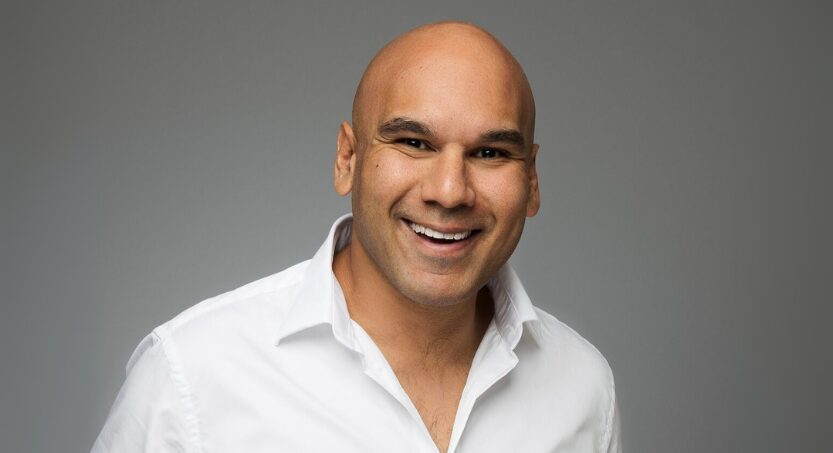How can philanthropy support more emerging First Nations leaders?

NAIDOC Week’s theme of ‘The Next Generation: Strength, Vision & Legacy’ speaks to the role of future leaders. Dr Bhiamie Williamson is Senior Lecturer at Monash University where he leads the National Indigenous Disaster Resilience research program. He shares his experience of leadership and says that philanthropy must back the next generation’s fresh ideas to really shift entrenched disadvantage.
Giving News (GN): You have leadership roles in academia, Indigenous land and sea management and in other Aboriginal and Torres Strait Islander spaces. What does leadership across these spheres mean to you?
Dr Bhiamie Williamson (BW): I come from generations of leaders. My parents were in leadership positions throughout their lives and their parents were leaders in different ways. The role and function of leadership has changed through the generations, but I’ve come to it in an organic, natural way.
I came to leadership with zest and vigor, and a keenness. But now my relationship with it is one of carefulness and reluctance. The way I experience leadership is many things, but the more important point is understanding it as something that’s not static. It’s a way of being that’s alive and responsive. It’s a mindset.
GN: How can we strengthen those traditions and organic pathways to knowledge and wisdom for young people today, given the challenges around social media and disconnection?
BW: I grew up in a complex of family and community, meaning that I was always engaged in observing and learning from people in positions of authority. I was lucky that people around me saw qualities in me lended to leadership, so I was mentored into that mindset from early on.
My experience in Indigenous governance is that leadership operates through individuals and through groups. Enough doesn’t get said for group leadership and our communities are adept at operating in this way.
There are notions of leadership we might call ‘Indigenous’ or even ‘Australian’. These notions of leadership emerge from these lands and water, and are imbued with things like responsibility and accountability, and they stem from knowledge, experience and recognition from their communities. Corporate modes of leadership or military hierarchies, they don’t come from here and they will not meet the complex challenges we all face in the future.
GN: There has been progress in relation to mainstream acceptance of Indigenous land and sea management practices through the work of organisations such as NAILSMA, Firesticks and Country Needs People, where you are Chair, among others. Given Traditional Owners’ deep connection to caring for Country, why has it taken so long for non-Indigenous Australian agencies to lean into their ancient wisdom?
BW: Australia has leaned into that knowledge historically, but when it was in their economic interest to do so. There are instances in colonial times, such as the establishment of the cattle industry in northern Australia or Aboriginal pearl divers, when early settlers and cattle barons embraced the knowledge of Country possessed by Indigenous people, but only as an economic imperative.
Now there’s a climate imperative, so the reason for support has changed, but the central purpose for Aboriginal and Torres Strait Islander communities in caring for Country is the same.
I lead a research programme focused on Indigenous peoples’ resilience in post-disaster settings and there are huge imperatives there to harness traditional knowledge. They are in land and sea management, which is key, but also community governance in overcoming social and cultural vulnerabilities, in which we are frankly far more advanced than non-Indigenous Australians. There is a lot to be learned by leaning into Indigenous knowledges more generally rather than for purposes that serve the interests of non-Indigenous people.
GN: The NAIDOC Week 2025 theme is ‘The Next Generation: Strength, Vision & Legacy’ and celebrates not only the ‘achievements of the past but the bright future ahead …’ It’s an optimistic outlook after all that has passed. How can philanthropy do more to support emerging First Nations leaders?
The next generation is a great theme for NAIDOC Week. There’s a generational imperative to look for fresh leadership in our communities, but that needs to also welcome new ideas. We sorely need fresh ideas and to evolve our goals and strategies to achieve them.
If the Voice referendum revealed one thing, it is that Aboriginal and Torres Strait Islander people have great friends in philanthropy. There’s a willingness and bravery, and that’s to be applauded. The question is, what do we do with that energy and friendship moving forward?
If we’re asking people to step into leadership positions, they need to be free to bring their new ideas and have them supported. New ideas, truly new ideas, are hard to sell. But these new ideas will only find life if they are backed beyond the traditional areas of investment. Despite the wonderful work that has been done in previous years, entrenched disadvantage remains.
There’s a need across the board to change what we do – not radically, but strategically, with a view that there’s greater efficiency and opportunity in that.
GN: What’s your vision or dream for a future Australia?
It would be less a dream and more a simple desire, to live uninterrupted by racism and disadvantage. Saying this kind of feels unfair, for living life free from discrimination is just something all people should enjoy. But as Aboriginal and Torres Strait Islander people, the fact is we still don’t enjoy this and it is everyone’s responsibility to overcome this.
Dr Williamson is a Euahlayi man from north-west NSW. He is a Director of the Australian Indigenous Governance Institute and will be speaking at the sold-out Philanthropy Leadership Summit.